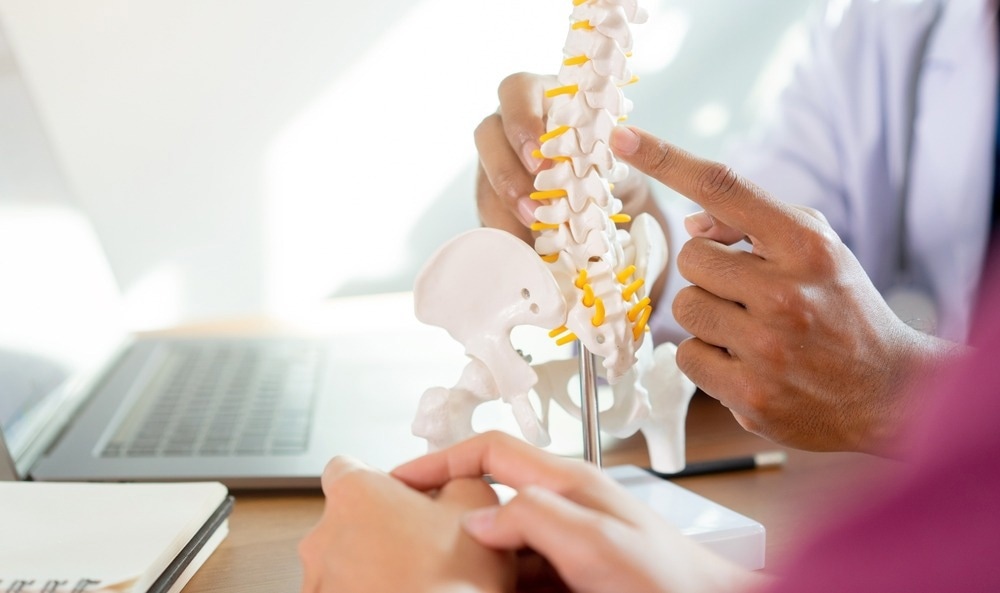 By Taha KhanReviewed by Lexie CornerMay 9 2024
By Taha KhanReviewed by Lexie CornerMay 9 2024Orthopedic surgery relies heavily on implants made from metals like titanium and stainless steel or biocompatible polymers such as polyethylene to repair fractures, replace damaged joints, and restore skeletal integrity. Despite their effectiveness, these materials present limitations that can affect long-term functionality.

Image Credit: chainarong06/Shutterstock.com
To tackle these challenges, researchers are focusing on composite biomaterials for improved orthopedic implants. These advanced materials offer unique properties that have the potential to overcome the limitations of traditional materials.1
What are Composite Biomaterials?
Composite biomaterials are engineered by combining two or more distinct constituents with complementary properties. This amalgamation results in a final material with superior characteristics compared to its individual components.
The constituents of composite biomaterials typically involve a polymer matrix that provides structure and binds other components together, alongside ceramic or fiber-based reinforcement to enhance the strength and stiffness of the composite. Depending on the application, the composite may also incorporate bioactive elements to stimulate bone ingrowth or improve tissue integration. 2
Composite biomaterials provide greater design flexibility than traditional materials like metals, as the mechanical properties of the final product can be altered for desired applications by manipulating the composition, ratio, and arrangement of the individual components. This enables the creation of implants that closely match the strength, elasticity, and wear resistance of bone.1, 2
Advantages of Composite Biomaterials in Orthopedics
Composite biomaterials provide numerous benefits in orthopedic surgery due to their capacity to be tailored to specific applications.
For instance, while patients may experience adverse reactions to metal implants, composite materials designed with biocompatible components can minimize the risk of implant rejection and provide better tissue integration.1, 3
Some metal implants are susceptible to fatigue and wear over time, necessitating revision surgery. Their composite counterparts, however, can be engineered for superior strength, potentially extending their lifespan and reducing the need for repeat procedures.
The ability to tailor the mechanical properties of composite biomaterials allows them to mimic the elasticity and stiffness of bone, providing improved stress distribution and a more natural sensation for the patient. Additionally, specific composite biomaterials can be designed to incorporate bioactive components that stimulate bone growth and promote stronger osseointegration.4, 5
Current Research and Innovations in Composite Biomaterials
UHMWPE Nanocomposites for Fracturue Healing
In a 2023 study, researchers investigated the use of composite biomaterials for orthopedic surgery, focusing on bone plates used in fracture healing. They developed ultrahigh molecular weight polyethylene (UHMWPE) nanocomposites reinforced with nanoparticles (n-HA and n-TiO2) and fibers (carbon and Kevlar).
The study evaluated cell viability, antibacterial activity, and wettability of these materials. Results showed good cell attachment on the surface of the nanocomposites, with the UHMWPE nanocomposite reinforced with carbon exhibiting superior cell attachment.5
The incorporation of nanoparticles and fiber reinforcement improved wettability and antibacterial properties. Specifically, the UHMWPE-4.5 % n-TiO2-CF biocomposite demonstrated excellent wettability and antibacterial activity against Staphylococcus aureus.
Thermal analysis revealed increased melting and crystallinity temperatures compared to pure UHMWPE, indicating enhanced thermal stability.5
Carbon Fiber Composite Innovations in Ligament Reconstruction
A 2021 study focused on advancing ligament reconstruction techniques using carbon fiber composites. The researchers developed composite filaments by reinforcing poly(L-lactic acid) (PLA) with graphite nanoplatelets (GNPs). Silver nanoparticles were also incorporated into the functionalized GNPs to confer antibacterial properties.6
The resulting composite filaments exhibited good dispersion of fillers and thermal stability. Mechanical analysis showed increased stiffness and energy dissipation capacity compared to pure PLA filaments. The electrical resistivity also decreased significantly with filler incorporation.
These composites demonstrated low degradation rates in simulated body fluid, and researchers successfully fabricated 3D scaffolds from these filaments, showcasing their potential for ligament tissue engineering applications. 6
Novel Composite for Bone Regeneration
In a 2023 study, researchers developed a novel composite material aimed at bone regeneration for orthopedic surgery.
This composite, comprising a treated dentin matrix (TDM) and a-calcium sulfate hemihydrate (a-CSH), demonstrated enhanced properties. By optimizing the ratio between TDM and a-CSH, the researchers achieved a composite with a stable structure and impressive compressive strength similar to human cancellous bone tissues. 7
Biological experiments revealed excellent biocompatibility and increased expression of osteogenic genes and proteins. In vivo experiments in rats demonstrated enhanced cell proliferation and osteomalacia with the addition of TDM, particularly in the 50 %TDM/a-CSH group, which displayed optimal osteoconductivity.
This innovative TDM/a-CSH composite has the potential for applications in bone tissue engineering for bone defect repair. 7
Future Prospects and Challenges in Composite Biomaterials
Composite biomaterials hold significant potential for the future of orthopedic surgery. Researchers continue to explore novel components and fabrication techniques, aiming to enhance the properties of these materials.
One key area is additive manufacturing, including 3D printing, which could enable the creation of patient-specific implants with high precision and accuracy.8 Further research is also underway to promote osseointegration and stimulate bone healing around implants.4
As the research and development in composite biomaterials for orthopedic surgery continue, these materials will replace traditional materials as a better alternative.
More from AZoM: What Are the Latest Innovations in Solid-State Battery Technologies?
References and Further Reading
- Al-Shalawi, FD., Ariff, AHM., Jung, DW., Mohd Ariffin, MKA., Seng Kim, CL., Brabazon, D., Al-Osaimi, MO. (2023). Biomaterials as implants in the orthopedic field for regenerative medicine: metal versus synthetic polymers. Polymers. https://doi.org/10.3390/polym15122601
- De Santis, R., Guarino, V., Ambrosio, L. (2019). Composite biomaterials for bone repair. In Bone repair biomaterials. Woodhead Publishing. doi.org/10.1016/B978-0-08-102451-5.00010-X
- Vallittu, PK. (2018). An overview of development and status of fiber-reinforced composites as dental and medical biomaterials. Acta biomaterialia odontologica Scandinavica. doi.org/10.1080/23337931.2018.1457445
- Chan, YH., Lew, WZ., Lu, E., Loretz, T., Lu, L., Lin, CT., Feng, SW. (2018). An evaluation of the biocompatibility and osseointegration of novel glass fiber reinforced composite implants: In vitro and in vivo studies. Dental Materials. doi.org/10.1016/j.dental.2017.12.001
- Kadhim, TR., Oleiwi, JK., Hamad, QA. (2023). Improving the biological properties of UHMWPE biocomposite for orthopedic applications. International Journal of Biomaterials. doi.org/10.1155/2023/4219841
- Silva, M., et al. (2021). Poly (lactic acid)/graphite nanoplatelet nanocomposite filaments for ligament scaffolds. Nanomaterials. doi.org/10.3390/nano11112796
- Guo, R., et al. (2023). Biomimetic, biodegradable and osteoinductive treated dentin matrix/α-calcium sulphate hemihydrate composite material for bone tissue engineering. Regenerative Biomaterials. doi.org/10.1093/rb/rbad061
- García‐Lizarribar, A., Fernández‐Garibay, X., Velasco‐Mallorquí, F., Castaño, A. G., Samitier, J., Ramon‐Azcon, J. (2018). Composite biomaterials as long‐lasting scaffolds for 3D bioprinting of highly aligned muscle tissue. Macromolecular bioscience. doi.org/10.1002/mabi.201800167
Disclaimer: The views expressed here are those of the author expressed in their private capacity and do not necessarily represent the views of AZoM.com Limited T/A AZoNetwork the owner and operator of this website. This disclaimer forms part of the Terms and conditions of use of this website.